Check The Specs...
NAME: John Stigge
FARM: Stigge & Sons Farm
LOCATION: Washington, Kan.
YEARS NO-TILLING: 30+
NO-TILL ACRES: 2,050
CROPS: Corn, soybeans, wheat, oats, milo and cattle
Desperation pushed us into no-till. It was the early 1980s and it wasn’t a great time to be a farmer. It also wasn’t a great time to need new equipment, which we did, unfortunately. We were out of money so instead of buying big new tractors and heavy new tillage implements, we made a few tweaks to our planter, took a deep breath and started no-tilling our crops.
While it was initially a forced issue, it didn’t take long for us to see it was the right decision no matter what. We weren’t using cover crops back then, so it took a couple of years to see a real benefit.
After 3 years of no-tilling we had a couple very dry years. We were able to harvest our corn crops during these tough times while our conventionally farming neighbors had to resort to chopping their corn to recoup their investment. That was one of the first signs we were doing the right thing.
Rain also brought about some realizations. My neighbor called me up after we got a 5-inch rain and asked what on earth we were doing so differently in our fields. He had observed the water flowing off his field was muddy and full of sediment, while the water coming off my field was nice and clear. I felt pretty good about that until it dawned on me that I was still losing that water. I continue to have these revelations, and they continue to push me to change the goals I have for my farm and the way I manage it.
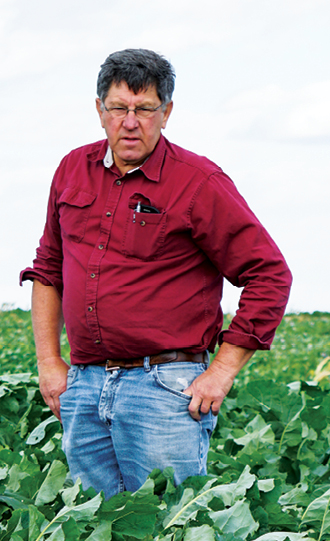
John Stigge
Many of the ideas come from attending the National No-Tillage Conference. I always come home with a few new things to try and a wealth of information gathered from speakers and my fellow no-tillers.
It was after attending the conference in Des Moines one year that we dove heavily into cover cropping. I was at a roundtable discussion and one gentleman asked at what slope are terraces necessary. A guy in an NRCS shirt said, ‘Well if you use no-till and if you use cover crops, terraces aren’t necessary until 20% or greater slope.’
This blew me away. We live 12 miles south of the Nebraska border and 120 miles west of the Missouri River so we have some hills to contend with. The next fall I planted rye and triticale and have waded deeper and deeper into cover crops ever since. That was about 20 years ago.
A few years ago one of our fields that has been in our cover-crop program the longest out-yielded the rest of the farm. It was a dryland field and my soybeans yielded 69 bushels per acre. My irrigated bottomland yielded in the low 60s.
It also topped the farm in wheat yields and the corn yields have been great, but don’t quite nudge out the irrigated acres.
Covers have also greatly improved our soil structure. After a dry spell we got a 4½-inch rain. I walked out in my fields and was able to walk on them, while the neighbor’s was slick.
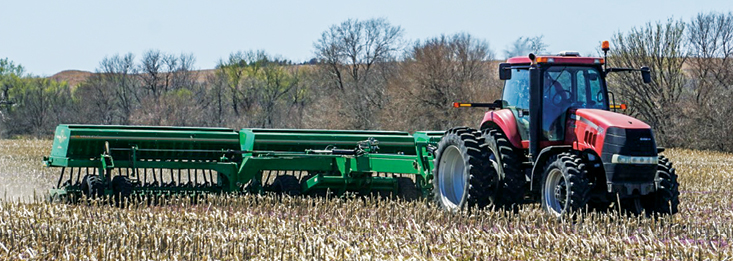
SOIL CONDITIONING. John Stigge drills 45 pounds of forage oats and 1 pound of Broadleaf Shield Mustard as a soil-conditioning mix into corn stalks that will be seeded to soybeans in the spring. The oats will add organic matter while the mustard frees up soil nutrients.
I dug down in each field. In his no-till field the moisture made it 7 inches, then the soil turned powder-dry. In my no-tilled field with a history of cover crops there was water as deep as I could dig.
We’ve stopped erosion and for the past several years we haven’t had to use insecticides or fungicides. The change is tremendous.
Cover crops have provided us with many benefits and opportunities to learn and change our system, including, most recently, the addition of grazing cattle.
Back to Beef
I farm with my sons Ian and Peter and my wife Kathryn. I grew up in a cattle family, but we got rid of the feedlot years ago. I may have been done with cattle, but my sons weren’t. When they came back to the farm they wanted to run cattle, which was surprising to me because they can be a lot of work.
They explained they wanted to accelerate what we were doing with soil health and they thought cattle could help. I had never really considered cattle as part of my cropping system until I listened to no-tillers Gabe Brown and Ken Miller talk about grazing cover crops at the Agricultural Innovative Minds Conference. With their positive experiences in mind, I was game to give it a try.
The Bayou Kale-Cross stands out as a superstar brassica in our cover-crop mixes…
Most of our permanent fencing was long gone, so we set up temporary electric fencing with polywire to make paddocks in our fields. The first year we grazed a cover- crop mixture of triticale and radishes that I seeded in wheat stubble. We grazed weaned calves there in late fall through early winter. They stayed on the field until it got too cold to haul water.
The next spring our hired man, Luke, was planting corn in the field. We hadn’t grazed the entire field, keeping the calves on roughly half the acres. I was on the other side of the field and was surprised to hear the tractor pull down and struggle as it transitioned from the acres we grazed to the acres that hadn’t been grazed. That was the complete opposite of what I expected and it repeated over and over again the whole length of the field.
In theory, the ground we grazed should have been a little more dense and difficult to pull through due to compaction from hoof traffic, while the acres with cover crops only should have been nice and mellow. Why?
I have no real scientific evidence for why that happened. I can speculate it was because the cattle added extra nutrients that our soil life needed to really work and go about building soil structure. This is still baffling, though, as it was cold and the soils were dormant while the cattle were there.
I may not know for certain what happened and why, but it was definitely an aha moment for me. And since improving our soil health is a major goal for us, we decided to continue down the livestock path.
Since that experience we’ve gotten more aggressive with our grazing programs. It’s definitely one big experiment as we figure out what covers will grow, when to graze them and how to manage them.
Figuring Covers
I’ve been experimenting with and using cover crops for years. Adding livestock to the equation meant we needed to reevaluate what went in cover-crop mixes and when we would plant them. Still, I follow some basic rules when making my selections.
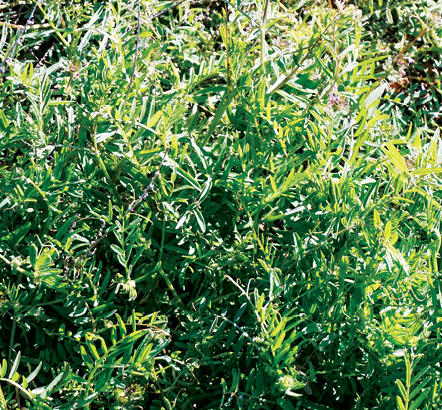
FREE NITROGEN. John Stigge drills 20 pounds of Naomi woolypod vetch in early March ahead of corn. It reportedly starts to fix nitrogen within 7 days of emergence. It also serves to mellow the ground and smother weeds. He can terminate it prior to or after planting corn.
For one, I don’t put too much emphasis on the number of species in my blends. I may run 3 or 16 different species in a mix depending on evaluation of conditions and how I intend to use the cover crops. Here’s how I decide what species make the cut:
- How does the species grow by itself? I have a test plot where I try different varieties or species. I evaluate their root growth, impact on soil structure, animal preference, insects they attract, how they compete with weeds (I don’t use any herbicides in the plots) and how it borders its neighbors. In other words, does it encroach or cede to encroachment?
- I evaluate any written information I can find on each species, noting its known characteristics. I use this to visualize how it might work for or against other plants in a mixture.
- Cost effectiveness, which I weigh by looking at how much it costs, the value of the benefits it gives, how reliable it is, what it does for the soil, what it does for the environment, how it will impact my next crop and if it can be used as a cash crop or grazing crop.
These considerations require hours of research, visual observation and spade work, but they’re worth it. It’s essential for me to have a goal, visualize a direction and work toward it.
When making my mixes I do demand effectiveness. I’ve found it to be a good practice to include at least one grass, legume and brassica in the mix.
The legumes are useful for nitrogen fixation and some disease and pest control aspects. The grasses serve to sequester carbon, build soil organic matter and provide deep soil improvement.
Brassicas balance the blend. Most brassica roots release an acid that helps pull calcium molecules away from other soil particles, which in turn releases phosphorus (P), sulfur and other minerals tied up in the soil.
I usually limit the brassica portion of a mix to 2 pounds. Any more than that may allow too much P to become available and possibly leach from the soil. Plus, because of the small nature of most brassica seeds, they can easily overwhelm the rest of the mix.
Adding Cattle
Now that livestock are part of the equation, I’ve done some more experimentation. Here are some observations from my 2015 adventures in cover crops and grazing.
For spring grazing I seeded a mix including 45 pounds of forage oats (late maturing oats) 2 pounds Seminole ladino clover, 10 pounds Naomi wooly pod vetch, 1 pound Bayou Kale-Cross and 10 pounds of TS-7 spring peas. This was seeded March 19 on dryland acres.
My objective with this mix was to provide a nutrient dense, high-energy ration for lactating cows and calves for late spring and early summer while also yielding an improvement to soil structure and water infiltration. The 150 acres seeded were rotationally grazed by 135 cow/calf pairs for 72 days starting in late April. Each paddock was grazed twice.
In this mix, the clover grew slowly and remained too small to provide a grazing benefit. The cows and calves were able to graze the oats, kale and vetch.
In observing the cattle grazing, they would hop from species to species, almost seeming to balance their rations as they grazed. They definitely enjoyed the diversity and thrived on the mix.
After the cover and grazing, soils seemed mellow so we met both goals. We terminated the crop in mid-June when the oats started to mature and the heat took a toll on the crop.
The Bayou kale cross really stands out as a superstar brassica in our cover-crop mixes. It’s a kale/rapeseed cross-bred by Saddle Butte Ag. It provides a deep, branching taproot, can be planted in the spring or fall and the cattle absolutely love it. They will grub it down to 3-4 inches and it provides them with minerals, reducing the number of supplements we have to put out.
In the spring I’ve noticed the undersides of the kale leaves swarmed with aphids, but 2-3 days later ladybugs show up in force and take them out. What’s amazing is in the years following we don’t seem to have near the problems with aphids in our soybeans as we do in fields where we didn’t have the kale in the mix.
We’re eventually trying to move to non-chemical farming, so we’re definitely paying attention to the kale.
In 2015 I started a new experiment with grazing and cover crops. We don’t have any pasture and my sons eventually want to raise grass-fed beef. Now that corn prices aren’t so high, we’re able to commit more acres to cover crops and meeting grazing needs.
One way we hope to accomplish this is through a short-life perennial grazing system we intend to graze for 2-3 years before returning it to cash crops. The goal is to enhance soil biology and carbon sequestration, hopefully putting roots deep into the soil profile.
On April 10 and Aug. 4, I seeded 10 pounds of Brutus tall fescue, 5 pounds Naomi wooly pod vetch, 20 pounds sainfoin, 2 pounds yellow blossom sweet clover, 2 pounds Mihi Persian clover, 0.7 pounds Bayou kale cross, 0.3 pounds shield broadleaf mustard, 2 pounds Boston plantain and 2 pounds Antler chicory.
This hasn’t gotten off to a perfect start. Wet weather kept us out of the field for grazing for a bit in the earlier planting, and the mustard quickly overwhelmed the rest of the seeding. This was a learning experience, though. I think I could easily use this as a spring-seeded smother crop to address tough winter annuals such as marestail.
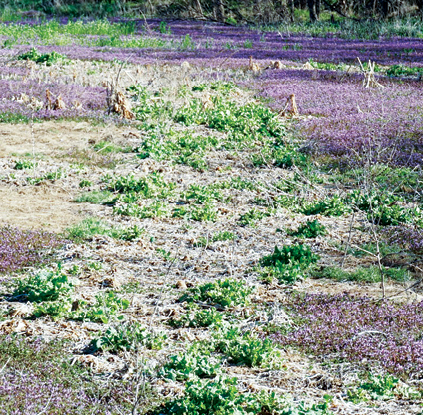
SMOTHERING WEEDS. A cover-crop mix drilled in August provided total winter annual control, an important task for John Stigge’s farm, which battles with marestail.
I left the mustard out of the later planting, but we didn’t get good moisture so results there haven’t been as encouraging either. We learn from failure, though, so I’m taking note and moving forward. Multi-season cover crops may not work for us, but we’re giving it a try.
Lofty Goals
My sons seem to have really caught the spirit of improving the operation. We’ve been inspired by conferences and going out to visit with folks like Gabe Brown.
Kathyrn and I visited Gabe in 2012, got to dig around in his soils and saw that they were like potting soil. And the water infiltration was incredible. We can have hot, dry winds that really sap moisture from our plants, so getting more water in our soil is a goal.
My focus on this and the long-term health of my soil is not only for my benefit, but for my sons. I want them to succeed in the future.
They see the improvements and recognize what’s going on. They sat me down last December and declared we should go organic. A few years ago I would have said not a chance, but I think now we’re realistically working toward that end through our use of cover crops, livestock and forward thinking.
Desperation may have driven us to no-till, and it took a while, but now we know it was for the best and we continue to learn and push our system forward.

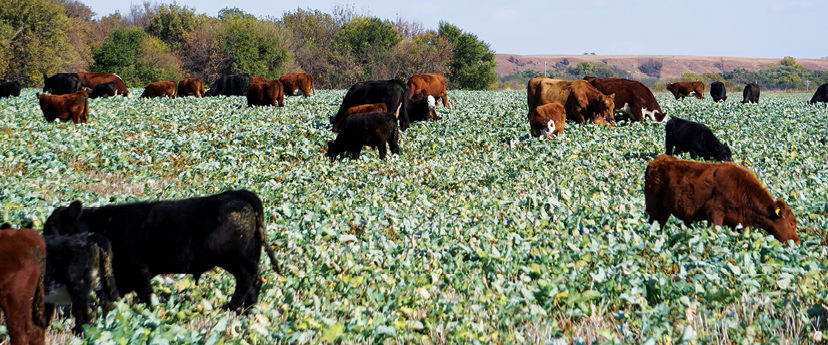






Post a comment
Report Abusive Comment